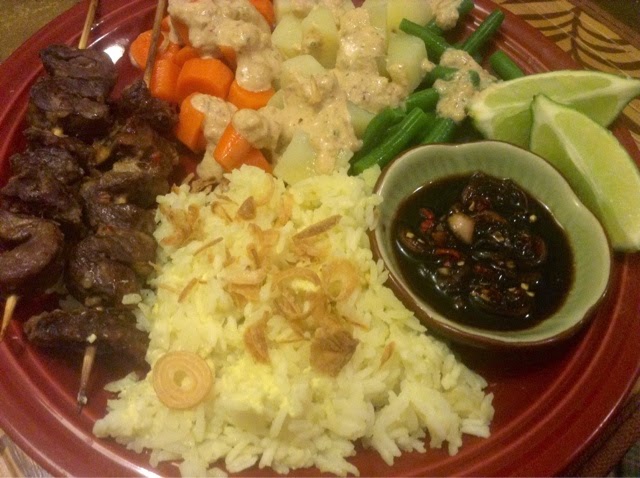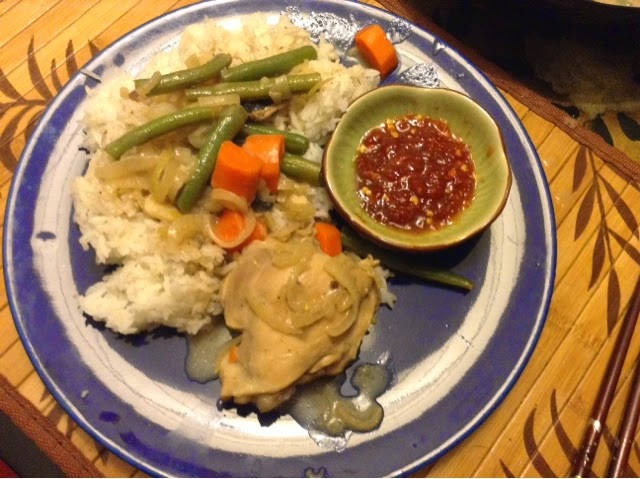J'ai pris les quantités pour la pâte d'une recette par SortedFood.com, une bande d'anglais trop drôles. Par contre, j'ai changé complètement l'ordre des ingrédients car j'utilise toujours la levure de la même façon, je me sens plus sécure!
-1/2c. à thé de levure
-1c. à thé de sel
-optionnel : 1c. à thé de poudre d'ail
Dissolvez la levure dans l'eau chaude et réservez.
Dans un bol pour mélanger, avec un fouet, combinez bien la farine, le sel, et la poudre d'ail si utilisée. Peu à peu, incorporez le mélange de levure et d'eau à la farine, en mélangeant avec l'autre main, jusqu'à l'obtention d'une boule (pas belle). Transférez la pâte sur un comptoir légèrement fariné et travaillez-la pendant 2 minutes. Arrosez la pâte avec la moitié de l'huile, et continuez de travaillez la pâte pendant 2 minutes de plus, jusqu'à ce que l'huile soit bien incorporée.
Dans le bol à mélanger nettoyé, versez le reste de l'huile, puis roulez la boule de pâte dans l'huile pour qu'elle soit totalement couverte. Recouvrez le tout avec du film plastique et laissez gonfler dans un endroit chaud pour une heure (j'allume mon four au minimum pendant que je fais la pâte, et quand elle est prête, j'éteinds le four et y met le bol avec ma pâte).
Après une heure, la pâte devrait être deux fois sa taille initiale. Transférez la pâte sur un comptoir et la pétrir pendant 30 secondes pour enlever le gaz. Ensuite, vous pouvez utiliser la pâte immédiatement, la mettre au frigo jusqu'au souper, ou la storer au congélateur pour plusieurs mois.
Pour faire la pizza, il faut une plaque de 12pouces (30cm) de diamètre. Fairiner légèrement la plaque avec de la farine de maïs (polenta, pas fécule de maïs) ou de la farine régulière. Sur le comptoir, roulez la pâte avec un rouleau à pâte jusqu'à ce que votre cercle de pâte mesure environ 14pouces (15-16pouces si vous faites une croûte farcie) pour qu'il y ait du jeu pour la croûte. Transférez la pizza sur la plaque. Si vous faites une croûte farcie, faites un cercle de fromage tout autour (et ajoutez de la sauce chili, du sambal oelek, de la bruschetta si vous voulez) environ où la plaque se termine. Fromage ou non, repliez la croûte tout autour, utilisez un doigt humide si ça ne colle pas bien. Voilà! Optionellement, vous pouvez légèrement mouiller la croûte et la parsemer de sésame, de graines graines de pavot, de ce qui vous plaît! Les garnitures suivent.
I took the quantities for the dough from SortedFood.com, but I changed the order you add the ingredients in to fit the way I always use yeast, so I feel safer! Please visit the SortedFood channel on YouTube, these guys are super funny!
Pizza dough:
-1/2tsp yeast
-170mL warm water (100F), my hot tap water is good...
-300g bread flour preferably, but this time I only had all-purpose and it was good
-1tsp salt
-optional: 1/2tsp garlic powder (took the idea from another Sorted pizza)
-1tbsp olive oil
Mix the water and yeast and set aside. In a medium mixing bowl and using a whisk, thoroughly mix the flour, salt, and garlic powder if using. Add a little bit of the yeast water at a time and mix with your other hand until the dough has gathered into a rough ball. Knead three minutes on a floured surface, then fold in half the olive oil and knead for another 2 minutes. Shape into a ball, put into the cleaned mixing bowl, add the oil and roll the ball in it until it's all covered in oil (prevents from drying). Cover everything with plastic wrap and leave to rise in a warm place for about an hour (I turn on my oven to minimum while I'm making the dough, then turn it off and leave the dough to rest there).
After an hour, it should have doubled in size. Knead the dough a little to remove the gaz. You can now use your dough or wrap it and keep it in the fridge until supper time or store it in the freezer.
To make the pizza, you'll need a 12inches (30cm) baking sheet, floured with corn flour (polenta, not cornstarch) or regular wheat flour. Roll out your dough on a floured surface. You want it to measure about 14inches wide, so it has an extra inch all around for the crust. If you're doing a stuffed crust, you can even roll it to 15-16inches wide. Lay the dough on the baking sheet, centered. Fold the dough all around the pizza to make a crust. If making a stuffed crust, make a ring of cheese around the pizza leaving an inch or so free. Add some chili or hot sauce or bruschetta if you'd like, then fold the dough around the cheese to make the crust. You can run you wet fingers on the dough before folding to make it stick better. To finish the crust, if you desire, you can wet the crust lightly and sprinkle it with sesame or poppy seeds, or any seeds you like. Toppings follow.

Voici comment je fais une toute petite quantité de sauce à la viande, rapidement, juste assez pour cette pizzaghetti. Vous serez surpris combien cette sauce simple est délicieuse. Quand vous n'avez pas 4 heures pour faire une sauce spaghetti, celle-ci est très bien. Par contre, si vous avez déjà de la sauce à la viande maison au frigo ou au congélateur, n'hésitez pas à utiliser celle-ci! Je ne conseille pas les sauces en jarres ou en cannes, aucune ne me plaît vraiment...
Spaghetti:
-1/2 ou 1 portion complète de spaghetti pour une personne (sur la photo j'ai utilisé des nouilles aux oeufs car je croyais que j'avais du spaghetti mais finalement non, mais je conseille fortement les spaghetti en boîte pour la texture)
-un bonne poignée de boeuf ou de porc haché
-2 gousses d'ail
-une poignée de basilic frais, haché
-sel et poivre
Pour la sauce, hachez les tomates et l'ail (j'utilise un robot cullinaire pour aller vite).
Faites cuire complètement la viande hachée dans une poêle anti-adhésive. Ensuite, ajoutez les tomates et l'ail et faites mijoter vigoureusement et mélangez de temps à autre jusqu'à ce qu'il n'y ait plus trop de liquide. Ajoutez le basilic, et salez et poivrez (ce devrait être légèrement trop salé pour que le goût de la sauce se démarque de tous les autres ingrédients sur la pizza).
Faites cuire le spaghetti, égouttez-le bien et mélangez-le avec la sauce dans un bol.
Étendez le spaghetti sur la pizza en premier, avant les autres garnitures.
-----------------------------------------------------------------------------------------------------------------------
Here's how I prepare a small quantity of meat sauce really fast just for one pizza. It is really good though, you could use this recipe for a simple quick meal with pastas, when you don't have 4 hours to simmer a proper sauce. If you've got some of your own spaghetti/meat sauce in the fridge or freezer, don't hesitate to use it instead, but I wouldn't recommend jarred or canned meat sauces, I don't like any of them.
Spaghetti:
-1/2 to 1 portion of boxed dried spaghetti or spaghettini (I used egg flat noodles because I thought I had spaghetti but I didn't, but the spaghetti's texture is way better for this pizza)
-1 handful of ground beef or pork
-2 cloves garlic
-a handful of basil leaves, chopped
-salt and pepper
For the sauce, start by chopping the tomatoes and garlic cloves really fine (I used a food processor). Stir-fry the ground meat in a non-stick pan. Once it's cooked, add the tomatoes and garlic and simmer on high while mixing every once in a while until there's not too much liquid left. Toss in the basil, then salt and pepper to taste, or a little saltier than to your taste should be perfect.
Cook spaghetti and drain them properly. Toss them in a bowl with the sauce, then distribute evenly on the pizza dough before your other toppings.
Pour la garniture, la pizzaghetti Miss Italia utilise:
-quelques champignons blancs, tranchés
-du bacon, j'ai utilisé 4 tranches coupées en deux (faites cuire le bacon dans un poêle adhésive deux minutes de chaque côté pour le faire suer un peu, ensuite égouttez-le bien sur du pauper absorbant, de cette façon le bacon sera parfaitement cuit et il n'y aura pas trop d'huile sur le fromage)
-je crois qu'il y a du poivron vert? je n'aime pas alors j'ai mis des tranches de chili
-beaucoup de mozzarella râpé, et plus encore si vous faites une croûte farcie!
Vous pouvez tout de même garnir votre pizza comme vous voulez. Souvenez-vous seulement que certains ingrédients, comme le bacon, doivent être précuit ou blanchit, de façon à ce qu'ils cuisent complètement en 10 à 15 minutes au four.
Dispersez vos ingrédients (gardez-en quelques morceaux pour décorer sur le fromage) sur le spaghetti. Recouvrez de fromage et décorez votre pizza avec ce qu'il reste. Le bacon doit être placé SUR le fromage pour qu'il grille.
Faites cuire votre pizzaghetti à 400F/200C pendant 12 minutes, et ensuite sous le grill (broil) pour 2-4 minutes, jusqu'à ce que le fromage et le bacon soient jolis et bien grillés. Laissez reposer 5 minutes sur le comptoir, et voilà!
J'espère que Maman et tout le monde aimera!
-----------------------------------------------------------------------------------------------------------------------
The Miss Italia pizzaghetti has:
-a couple white mushrooms, sliced
-bacon, I used 4 slices cut in two (make the bacon sweat just a minute or two on each side in a non-stick pan, then drain on paper towels, this way the bacon will be perfectly cooked and there won't be a lot of oil on top of the cheese)
-I think green bellpeppers, I can't remember, I don't like them so I put green long hot peppers, sliced
-a lot of grated mozzarella, and even more if you make a stuffed crust!
You can still put anything you'd like. Just remember some ingredients might need to be blanched or precooked like bacon so they cook properly within 15 minutes in the oven.
Just lay your toppings on top of the spaghetti (you can keep some to decorate). Cover with cheese, then add remaining ingredients. Bacon should be placed on top so it crisps up.
Put the pizza in the oven at 400F/200C for 12 minutes, then broil for 2-4 minutes (keep an eye on it so it doesn't burn). Let the cheese set on the counter for 5 minutes, then enjoy!























